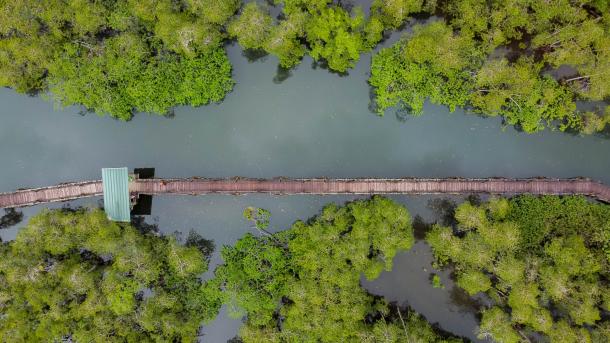Event
Mangroves: Our Allies Against Climate Change
Have you ever wondered why people consider mangrove forests to be our allies against climate change? Do you know whether your country has mangroves and how much land these cover? A new exhibition sets out to answer these and other questions. A series of 125 posters combine stunning photos with interesting facts and figures on the mangroves of the world. These posters will be visible on the railings that surround UNESCO headquarters in Paris until the end of September 2023.

This photo exhibition takes us on a world tour, since there is a poster for every country in the world that has natural mangrove stands, as well as some of their overseas territories.
Mangroves occupy the boundary between land and sea. At a time when sea levels are rising as a consequence of climate change, mangrove forests are of particular interest to scientists, since they are able to thrive in relatively saline soils.
Mangroves are widespread, growing in sheltered lagoons and deltas in the tropics and subtropics in the Americas, Africa, the Middle East, Asia and the Pacific. The Sundarbans, which straddles Bangladesh and India, is the world’s largest stand-alone mangrove forest.
Mangrove forests sustain local communities by providing them with seafood, wood and other products. They also mitigate the impact of climate change by sequestering carbon and protecting the coast from storm surges.
However, mangroves are also vulnerable. Many have been lost to coastal development. Some countries have even lost more than 40% of their mangrove area in the past 25 years! Those mangroves that remain cover about 152 000 km2, slightly more than the size of Nepal.
The exhibition mentions projects in which communities living in some of UNESCO’s 748 biosphere reserves in 134 countries are striving to conserve mangroves. This is the case in Savegre Biosphere Reserve in Costa Rica, for instance.
More than 275 million people around the world live in a biosphere reserve. These territories are contributing to the conservation of mangroves by reconciling people with nature through dialogue, knowledge-sharing, poverty reduction and green jobs.
The networks of UNESCO Global Geoparks and UNESCO World Heritage properties are also contributing to mangrove conservation.
This exhibition has been developed by UNESCO with financial support from WorldLife Spaces. It is planned to show the exhibition in different countries around the world once it leaves Paris.




